Setting Up Financial Aid Term for HERA Academic Level Calculations
Two methods exist for calculating a student's HERA academic level. The method that you use is determined by the aid year for which you assessing a student's eligibility for an ACG or SMART grant.
For aid years 2008 and 2010 onwards, you must monitor students' academic progress using grade levels determined by total completed units and the load level rule assigned in the HERA Academic Level Rule Setup page.
This method is called the HERA Level/Load Rule method in PeopleSoft documentation.
For aid year 2009, you must monitor students' academic progress based on the school's federal academic year (completed units and weeks of instructions).
This method is called the Federal Academic Year method in PeopleSoft documenation.
Note: You may see unexpected HERA academic level calculations as a result of the calculation methods changing from one aid year to the next. The Financial Aid Term process continues to determine HERA academic levels using the appropriate calculation method for the term's aid year.
This section includes an overview of HERA academic level calculations with examples and discusses how to:
Define the HERA academic level calculation rules.
Copy setup data from year to year.
Define parameters for Weeks of Instruction calculations.
This overview contains discussions about:
Describing the HERA Level/Load Rule method.
Describing the Federal Academic Year method.
Steps for calculating HERA academic levels using the Federal Academic Year method.
Describing the HERA Level/Load Rule Method
The HERA Level/Load Rule method is based on the total number of units completed towards the student's degree.
Note: Remember that you must use the HERA Level/Load Rule method for the 2010 aid year onwards.
The following graphic shows the steps for the HERA Level/Load Rule method.
Image: HERA Level/Load Rule method for calculating HERA academic levels
This example illustrates the HERA Level/Load Rule method for calculating HERA academic levels.
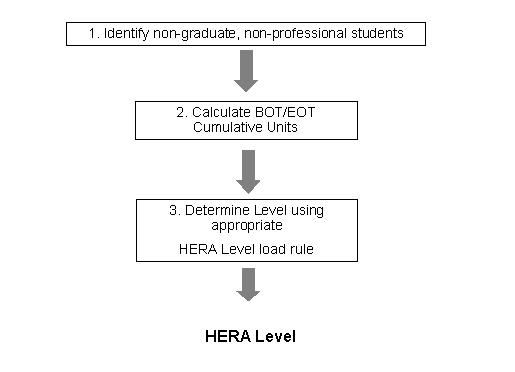
Describing the Federal Academic Year Method
To calculate a student's HERA academic level using the Federal Academic Year method, the two components of the institution's federal academic year are measured:
Total number of completed units.
Number of completed weeks of instruction (WI).
Both components are then used to determine the student's level. The level is based on each component meeting a specific threshold.
Note: Remember that you must use the Federal Academic Year method for the 2009 aid year only.
The following graphics shows the steps for the Federal Academic Year method:
Image: Federal Academic Year method for calculating HERA academic levels
This example illustrates the Federal Academic Year method for calculating HERA academic levels.
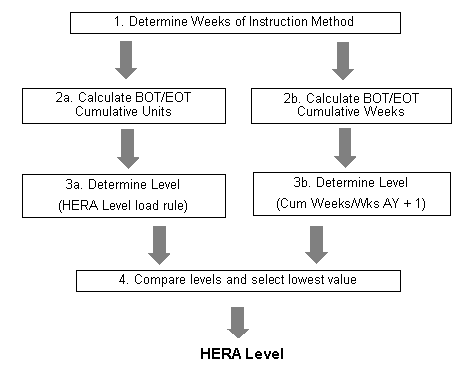
In the following two examples for calculating HERA academic level and monitoring progression, the term-based institution has a 30-week academic year of 24 units. The fall and spring terms are 15 weeks and the summer term is 10 weeks. Term Units Enrolled and Term Weeks of Instruction are cumulative at the end of the term.
In the first example, the student enrolls for 12 units each term:
|
Term |
Term Units Enrolled |
Term Weeks of Instruction (WI) |
Beginning of Term Level |
End of Term Level |
|---|---|---|---|---|
|
Fall 2007 |
12 (12) |
15 (15) |
1 |
1 |
|
Spring 2008 |
12 (24) |
15 (30) |
1 |
2 |
|
Fall 2008 |
12 (36) |
15 (45) |
2 |
2 |
|
Spring 2009 |
12 (48) |
15 (60) |
2 |
2 |
By the end of the spring 2008 term, the student reaches the second year level by meeting the level thresholds for both the units and weeks of instruction. By the end of the spring 2009 term, the student reaches the third year level.
In the second example, the student begins enrollment in the spring 2008 term:
|
Term |
Term Units Enrolled |
Term Weeks of Instruction (WI) |
Beginning of Term Level |
End of Term Level |
|---|---|---|---|---|
|
Spring 2008 |
12 (12) |
15 (15) |
1 |
1 |
|
Summer 2008 |
12 (24) |
10 (25) |
1 |
1 |
|
Fall 2008 |
12 (36) |
15 (40) |
1 |
2 |
|
Spring 2009 |
12 (48) |
15 (55) |
2 |
2 |
By the end of the student's summer 2008 term, the unit threshold for a second year student is met, but not the WI threshold. The student remains at the first year level at the end of the term. By the end of the fall 2008 term, the student completes enough WI to advance to a second year level.
Steps for Calculating HERA Academic Levels Using the Federal Academic Year Method
For all aid years and academic level methods, HERA academic levels are calculated for only non-graduate, non-professional students based on the NSLDS year.
To calculate HERA academic levels using the Federal Academic Year method:
1. Determine the method for Weeks of Instruction.
2a. Calculate Beginning of Term and End of Term Cumulative Units.
2b. Calculate Beginning of Term and End of Term Cumulative Weeks.
3a. Determine level from Cumulative Units.
3b. Determine level from Cumulative Weeks.
4. Compare levels to determine HERA academic level.
Note: Remember that the Federal Academic Year method is currently used for aid year 2009 only.
Here is more detailed information about each step:
1. Determine the Method for Calculating Weeks of Instruction
Refer to the final regulations to determine which of the four methods are available to your institution. Then select the method to use for calculating weeks of instruction or ignoring weeks of instruction. The four methods are:
|
Field or Control |
Definition |
|---|---|
| Exact Accounting |
This method derives WI from the scheduled dates of the enrolled classes in the term. The current method for calculating WI for budgets and Pell awarding is used. |
|
Field or Control |
Definition |
|---|---|
| Terms Attended |
This method assumes that every term has the same WI value, including nonstandard terms. WI equals the number of weeks in a school's academic year divided by the number of payment terms. |
|
Field or Control |
Definition |
|---|---|
| Credits Earned |
This method derives a WI value by converting the enrolled units for a term to a WI value. The ED formula is: (# units in term x #weeks in academic year) / (# of units in academic year) For example, if a student enrolls in 12 units for a term and the school has a 24 unit, 30 week academic year, the term weeks would be (12 x 30)/24 = 15 weeks of instruction. |
|
Field or Control |
Definition |
|---|---|
| Grade Level |
This method does not calculate weeks of instruction. The student's HERA academic level is calculated based on the number of acceptable units completed by the student. This is calculated by taking the total number of completed units (including transfer units) and then subtracting unacceptable work, such as Advanced Placement, International Baccalaureate, testing out, life experience, work experience, remedial, and units earned while not in an eligible program. Use the remaining units to derive the HERA academic level using the HERA academic level rules. The Grade Level method is based on the assumption that if a student is completing enough units to advance a grade level according to the school's requirements, then the weeks of instruction requirement is being satisfied. |
2a. Calculate Beginning of Term and End of Term Cumulative Units
Calculating cumulative units is similar for both the HERA Level/Load Rule and Federal Academic Year methods. The following table explains how cumulative units are calculated for the three methods that use weeks of instruction and the Grade Level method is explained after the table.
|
Cumulative Units |
Projected Term |
Enrolled, Term Not Started |
Enrolled, Term in Progress |
Term Completed |
|---|---|---|---|---|
|
Beginning of Term |
All completed units less the current term plus Transfer, Test credit, and other units, less adjustments. Excess FA Units assigned to remedial type courses are not included. |
Same |
Same |
Same |
|
End of Term |
Same units calculated for Beginning of Term plus projected units for the current term. |
Same units calculated for Beginning of Term plus enrolled units for the current term. |
Same units calculated for Beginning of Term plus anticipated, in progress, and competed units. |
Same units calculated for Beginning of Term plus completed units for the current term. |
The Grade Level method follows the same rules as the other three methods except that it does not allow certain transfer work to be included in the cumulative units. The transfer units not allowed are the same as those not allowed in calculating weeks of instruction for the other methods, which includes:
Advanced Placement
International Baccalaureate
Testing out
Life experience
Work experience
Units earned while not enrolled in an eligible program.
This transfer work is identified in the transfer credit evaluation module during the review for inclusion in the Financial Aid Weeks of Instruction statistics. The HERA Academic Level page (Financial Aid, Financial Aid Term, Maintain Student Financial Aid Term, Acad Level, click the View HERA Academic Level link) displays the beginning of term and end of term cumulative units.
2b. Calculate Beginning of Term and End of Term Cumulative Weeks
To calculate the cumulative weeks of instruction (WI), the FA Term module first calculates WI for each term the student was enrolled (and expected to enroll for projected terms). If a student has transfer work, a separate WI might also be calculated for those transfer units. Note that WI must be calculated for terms prior to the 2009 aid year.
The Term Weeks field on the HERA Academic Level page documents the weeks of instruction per term. Term weeks is usually recalculated when a student's enrollment for a term changes. There are also conditions where the term weeks resets to zero if the student does not enroll or fails to complete any courses. As shown in the following table, calculation of Term Weeks varies depending on when FA Term is run.
|
Calculation Method |
When |
How Term Weeks Value Is Calculated |
|---|---|---|
|
Exact Accounting |
Pre-enrollment |
Assigns the number of weeks of the default session that is set up for the term. |
|
During Enrollment |
Recalculated based on the schedule of each enrolled course. |
|
|
End of Term |
Term Weeks are reset to zero under these conditions:
Transfer weeks are unaffected by these conditions. |
|
|
Terms Attended |
Pre-enrollment |
Defaults to the calculated value of the number of weeks in the academic year divided by the number of payment periods in the academic year. |
|
During Enrollment |
Does not change. |
|
|
End of Term |
Term Weeks are reset to zero under these conditions:
Transfer weeks are unaffected by these conditions. |
|
|
Credits Earned |
Pre-enrollment |
Based on the projected enrolled units FA term uses to determine load. |
|
During Enrollment |
Adjusts based on changes to the number of enrolled units. |
|
|
End of Term |
Term Weeks are reset to zero under these conditions:
Transfer weeks are unaffected by these conditions. |
|
|
Grade Level |
Pre-enrollment |
Not Applicable |
|
During Enrollment |
Not Applicable |
|
|
End of Term |
Not Applicable |
To calculate Transfer Weeks of Instruction, use the formula:
(# total adjusted transfer units x #weeks in academic year) / # of units in academic year
where # total adjusted transfer units is the number of transfer units accepted by the school less any unacceptable transfer work, such as Advanced Placement, International Baccalaureate, testing out, life experience, work experience, remedial, and units earned while not in an eligible program. FA Term automatically calculates transfer weeks of instruction and stores the value in the Transfer Weeks field.
For example, if a student transfers in 15 units (12 regular, 3 AP units) to a 24 unit, 30 week school, the transfer weeks would be (12 x 30) / 24 = 5 transfer weeks.
Note: Transfer Weeks of Instruction calculation is not required when using the Grade Level method.
For information on reviewing and updating transfer credit information,
See Reviewing Transfer Work for FA Term HERA Level Determination.
To calculate Cumulative Weeks of Instruction, add the Term Weeks and Transfer Weeks values from all prior FA Term rows:
|
Field or Control |
Definition |
|---|---|
| BOT Cumulative Weeks of Instruction |
All previous terms Term WI and Transfer WI values where the term end date has passed and at least 1 credit earned plus Current Term Transfer WI. |
| EOT Cumulative Weeks of Instruction |
BOT Cumulative Weeks of Instruction plus Current Term Weeks of Instruction. |
3a. Determine Level from Cumulative Units
Determine the level from cumulative units by applying the academic level rule found in the HERA Level Rule Set Up page
Here is an example of a HERA level rule a school might create:
|
Field or Control |
Definition |
|---|---|
| Level 1 |
10–23 completed units |
| Level 2 |
24–47 completed units |
| Level 3 |
48–71 completed units |
| Level 4 |
72–120 completed units |
A student with 50 cumulative units would have a calculated level of 3.
3b. Determine Level from Cumulative Weeks
To determine the level from cumulative weeks, use this formula:
(Cumulative Weeks of Instruction / # of weeks in academic year) + 1
The number of weeks in the academic year is taken from the value in the Hours/Credit in Acad Year field on the HERA Weeks of Instruction Set Up page based on the student's career, academic program, or academic plan. There is no rounding of fractional data.
For example, if the cumulative number of weeks is 45 and the number of weeks in the academic year is 30 weeks, the level would be (45 weeks / 30 weeks) + 1 = 2.5 (second year).
4. Compare Levels to Determine HERA Academic Level
To determine the HERA academic level, compare the levels derived from cumulative units and cumulative weeks and assign the lower value. In the previous examples, if the level from units is 3 and the level from weeks is 2, then the HERA academic level assigned is 2 (second year).
Note that the Grade Level method does not calculate a level from WI. Instead, the level calculated from units is assigned as the HERA level from the Cumulative Units calculation.
|
Page Name |
Definition Name |
Navigation |
Usage |
|---|---|---|---|
|
HERA Academic Level Rule Set Up |
SFA_ASG_AL_TBL |
|
Set up and maintain HERA academic level rules, which are used by FA Term to calculate the credit portion of the undergraduate student's academic level. |
|
Copy HERA Academic Level Set Up |
SFA_ASG_AL_COPY |
Click the Copy button on the HERA Academic Level Rule Set Up page. |
Copy HERA academic level parameters from one aid year to another. |
|
HERA Weeks of Instruction Set Up |
SFA_ASG_WI_TBL |
|
Select parameters used to calculate a weeks of instruction value for non-graduate, non-professional level students. |
Access the HERA Academic Level Rule Set Up page ().
Image: HERA Academic Level Rule Setup page
This example illustrates the fields and controls on the HERA Academic Level Rule Setup page. You can find definitions for the fields and controls later on this page.
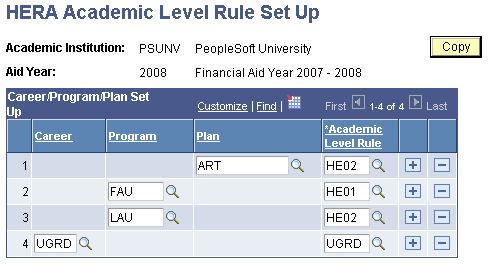
Use this page to assign HERA-level-specific academic level load rules for calculating the student's levels and to set the default level load rule for your undergraduate academic careers. Under the Federal Academic Year method, these setting are used to calculate the credit portion of the student's academic level.
The setup structure is aid-year specific to allow flexibility in assigning different Academic Level rules if the rules change from year to year. The Financial Aid Term process calculates HERA academic student level values to be used to evaluate, award, and disburse ACG and SMART grants.
For academic programs or academic plans that require a separate academic level rule, define those programs and plans. The FA Term build process determines the academic level rule to use based on finding a matching row with the student's information in the following order: Plan, Program, Career.
|
Field or Control |
Definition |
|---|---|
| Copy |
Use this button to copy setup data from one aid year to another. You can also use the Aid Year Rollover process (Set Up SACR, Product Related, Financial Aid, Aid Year, Aid Year Setup) to copy this setup information. |
| Career |
Select each undergraduate academic career that could qualify for ACG or SMART grants. |
| Program |
Enter only those academic programs that require a different academic level rule to calculate their HERA academic level different from the rule defined for the student's academic career. |
| Plan |
Enter only those academic plans that require a different academic level rule to calculate their HERA academic level different from the rule defined for the student's academic career or academic program. |
| Academic Level Rule |
Select the academic level load rule to calculate the student's HERA student level progression. The academic level rules are created in the Level/Load Rules Table page. |
Access the Copy HERA Academic Level Set Up page (click the Copy button on the HERA Academic Level Rule Set Up page.)
Image: Copy HERA Academic Level Set Up page
This example illustrates the fields and controls on the Copy HERA Academic Level Set Up page.
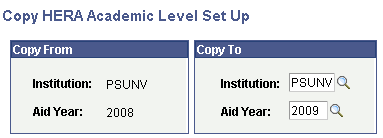
Warning! Because the HERA Academic Level setup includes the aid year, you must set up data for each aid year that requires the HERA academic level to be calculated. The HERA academic level is not calculated if this setup is missing for a particular aid year.
Access the HERA Weeks of Instruction Set Up page ().
Image: HERA Weeks of Instruction Set Up page
This example illustrates the fields and controls on the HERA Weeks of Instruction Set Up page. You can find definitions for the fields and controls later on this page.
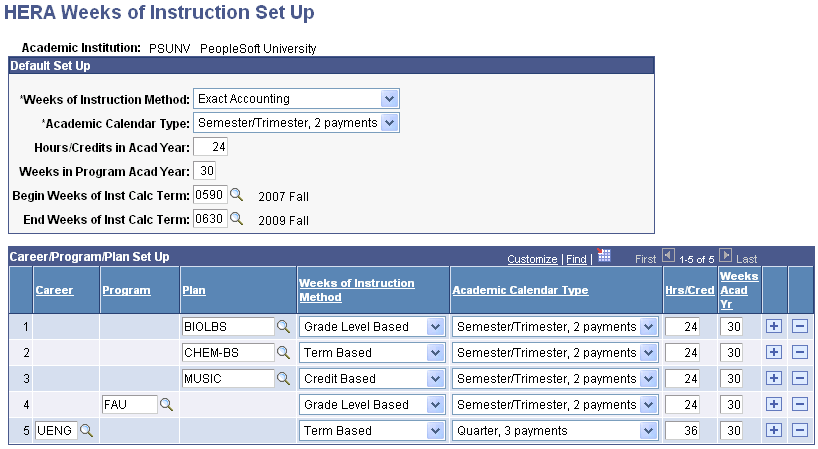
Use this page to select and store the parameters used to calculate a weeks of instruction value. These are applied to all non-graduate, non-professional level students.
Default Setup
|
Field or Control |
Definition |
|---|---|
| Weeks of Instruction Method |
Select the method by which weeks of instruction is calculated. Values are: Credit Based Exact Accounting Grade Level Based Term based |
| Academic Calendar Type |
Select the number of regular terms and payment periods. Values are: Quarter, 3 payments Quarter, 4 payments Semester/Trimester, 2 payments Semester/Trimester, 3 payments |
| Hours/Credits in Acad Year (hours or credits in the academic year) |
Enter the number of hours or credits that defines the academic year. |
| Weeks in Program Acad Year (weeks in program academic year) |
Enter the number of weeks of instruction that defines the academic year. |
| Begin Weeks of Inst Calc Term (begin weeks of instruction for calculating term) |
Enter the first term in which the calculated weeks of instruction is used to determine the student's HERA academic level. This should be the first term of the 2009 aid year. |
| End Weeks of Inst Calc Term (end weeks of instruction for calculating term) |
Enter the first term for the 2010 aid year for which weeks of instruction is not used in determining the HERA academic level. Starting with this term, HERA levels are calculated based on the schools academic level progression defined in the HERA Academic Level Setup component. |
Note: The Grade Level method does not require a completed Hours/Credits in Acad Year field or Weeks in Program Acad Year field to perform a HERA level calculation. You must provide information however, to support the HERA level calculation when a manual override of the student's weeks of instruction method is performed.
Career/Program/Plan Set Up
Use this group box to set up specific careers, programs, or plans. Default values display when you select a career, program, or plan; you can override any of the defaults.
The Career/Program/Plan Set Up group box contains the same calculation parameters that are applied to specific academic careers, academic program, or academic plans. When FA Term calculates a student's HERA academic level, the process determines which settings to use searching first for the student's academic plan, then the academic program, then academic career. If none is found, FA Term code uses the default setting to calculate the student's weeks of instruction.